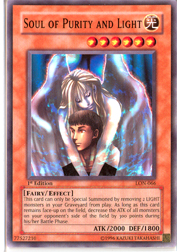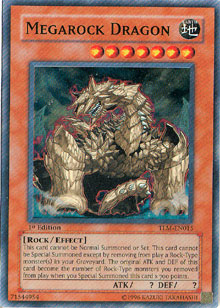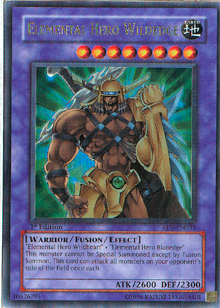Back for more Return ideas, huh? Good! More Return ideas are what I have to offer! Last week I showed you a few cards you might not have thought about before, and this week, there’s even more. Hopefully it will get you started on ideas for the upcoming format—we’d all like to see a bit of variation, wouldn’t we?
First, let’s take a moment and discuss the kinds of cards that made the cut to this week’s list. Any card I considered had to be able to remove my own monsters from the game (obviously) but one monster wasn’t good enough—each card needed to be able to remove at least two, all on its own. That’s why you won’t see cards like Gigantes or Silpheed on this list. Monsters like that can certainly function as wonderful support cards in a Return variant, but they can’t carry the entire deck on their own, and they probably won’t be integral—just nice to have. Speed is a big issue when you’re talking about any sort of combo deck, so cards that shuck a solitary monster from the game just aren’t fast enough, especially for an unpredictable metagame.
Let’s look at the second part of the list!
Soul of Purity and Light
 This is one of the most intriguing remove-from-game monsters available. Soul’s 2000 ATK makes it a powerhouse in battle, except when it’s facing down Cyber Dragon. That sucks . . . but wait! It gets fun! Once Cyber Dragon’s controller becomes the turn player, Soul’s effect will drop Cyber Dragon’s ATK by 300 points, so the dragon can’t attack it either. It’s an interesting stalemate that you can take advantage of if you’re prepared.
This is one of the most intriguing remove-from-game monsters available. Soul’s 2000 ATK makes it a powerhouse in battle, except when it’s facing down Cyber Dragon. That sucks . . . but wait! It gets fun! Once Cyber Dragon’s controller becomes the turn player, Soul’s effect will drop Cyber Dragon’s ATK by 300 points, so the dragon can’t attack it either. It’s an interesting stalemate that you can take advantage of if you’re prepared.
Soul of Purity and Light lets you remove two Light monsters from the game, so it draws off the same cadre of support as Freed the Brave Wanderer. Skelengel, Shining Angel, Asura Priest, and the soon-to-be-released Satellite Cannon all love the Soul, and it can even set you up to Return multiple Cyber Dragon and Airknight Parshath cards to the field. It’s nice with Zaborg the Thunder Monarch too, thriving off the monarch’s expended field presence when it hits the graveyard, or providing special summoned tribute fodder when you need to get Zaborg into play. Its effect is the real gem though—locking down your opponent’s monsters by reducing their ATK can be extremely powerful once you’ve had some practice at it.
Fenrir
Fenrir is more or less the same as Soul of Purity and Light—a monster that you special summon by removing two attribute-themed monsters from your graveyard (in this case two Water monsters). While Water monsters don’t see a ton of play, think about all the great ones that mess with your opponent’s plans: Mobius the Frost Monarch is pretty awesome to Return, while Abyss Soldier can pack a punch too. The latter can actually help you load your graveyard with Water monsters and speed the process through which you’ll bring Fenrir to the field. Cool stuff. Nightmare Penguin is a top pick for Water decks too, and though its 900 ATK might not seem impressive, its secondary effect (which gives all your Water monsters 200 more ATK) really adds up when you’ve got a field full of monsters from Return.
Fenrir’s effect helps make it a winner. Even if it’s just destroying minor monsters, it’ll prevent the opponent from seeing his or her draw phase. Play your cards right and use effects like Rush Recklessly, and you can lock your opponent out of the game entirely while you dig for Return and build your field.
Peten the Dark Clown
Peten is not an amazing monster to call back to the field with Return, but it’s incredibly self-sufficient. Not only can it maintain board presence when other recruiter monsters can’t, but it removes itself from play instead of removing another monster. That makes Peten exceptionally easy to use, and while it only has 500 ATK, it makes a nice splash for any Return deck.
Why put it in? Well, Peten’s pretty useful. First, it’ll thin your deck by three cards relatively quickly, helping you draw into Return. Second, it’s a solid wall no matter what the opponent throws at you. Deck Devastation Virus getting you down? Even losing Peten to the Virus’s effect will allow you to summon another from your deck, keeping you in the game until you can mount a comeback. When you do, you’ll have three more monsters waiting in the wings than you wouldn’t have otherwise. Peten was a tough choice to put on this list, since it can’t make for a Return win on its own very often, but it’s just so synergetic with Return that it seemed wise to include it. If you’re going to play Peten, though, make sure you understand its timing issues perfectly, to avoid problems at your tournament.
Megarock Dragon
 The last monster discussed here is one of the most unique. Megarock Dragon stands apart from the crowd as the only monster that lets you remove as many monsters from your graveyard as you like. Think about it—speed is of the essence sometimes, and while many cards on this list will remove two monsters to be Returned, few remove more. Dark Necrofear removes three, and Bazoo can do up to three, but Megarock Dragon can strip your graveyard of four choice Rock monsters and send them into the different dimension.
The last monster discussed here is one of the most unique. Megarock Dragon stands apart from the crowd as the only monster that lets you remove as many monsters from your graveyard as you like. Think about it—speed is of the essence sometimes, and while many cards on this list will remove two monsters to be Returned, few remove more. Dark Necrofear removes three, and Bazoo can do up to three, but Megarock Dragon can strip your graveyard of four choice Rock monsters and send them into the different dimension.
You can have nothing in your hand, nothing but Return set, and draw into Megarock Dragon, and suddenly you can have a field of five huge monsters. The Dragon itself can reach ridiculous proportions, often hitting 4200 ATK or more, but think about what it can bring back, too. Granmarg the Rock Monarch has 2400 ATK, and Rock-types like Golem Sentry and Guardian Sphinx can turn themselves face down after being Returned to stay on the field. That’s pretty darn cool, and makes your Returns very flexible. Plus, it’s such an offbeat card—you’ll have a lot of fun whomping on people with it, especially after they’ve given you that “what a noob” look after you’ve summoned it.
Skull Lair
Remember Aaron Eaton‘s deck at last year’s Shonen Jump Championship Los Angeles? He used a ton of recruiter monsters and Skull Lair to fuel huge Gren Maju Da Eiza cards. With Nobleman of Crossout down to one per deck, that strategy is viable again, but the Lair is also a nice support engine for Return from the Different Dimension. Like Megarock Dragon, Skull Lair lets you remove countless monsters en masse from your graveyard. At the same time, it also softens up the field for your game-winning attacks. Mystic Swordsman LV2, Spirit Reaper, and other little monsters bow down to this trap, and it can even take care of higher-level monsters like Zaborg and Mobius with a bit of time. Its high utility might make it a very good pick for the new Advanced format.
Remove From Game Fusions
Taken a look at your fusion options lately? There are actually plenty of cards that will remove your fusion material monsters from the game instead of just sending them to the graveyard. Some of them will allow you to fuse monsters without drawing on in-play or in-hand cards. Overload Fusion, Miracle Fusion, and Dragon's Mirror are all perfect examples, fusing Dark Machines, Elemental Heroes, and Dragons respectively. Fusion Gate is also useful, allowing you to fuse multiple monsters with a single spell and removing the fusion materials from the game.
 The Overload Fusion/Chimeratech combo should be pretty obvious by now, but imagine fusing Elemental Hero Wildheart and Elemental Hero Bladedge to bring out Elemental Hero Wildedge, then bringing back both Wildheart and Bladedge with Return. Or better yet, how about fusion summoning Blue-Eyes Ultimate Dragon and then bringing back three copies of Blue-Eyes White Dragon? Talk about a beating, and all done with cards that plenty of players look down their noses at. That makes it much more irritating for them when they lose. Admittedly these are drastic examples, but they are possibilities, and that’s what I was hoping to present.
The Overload Fusion/Chimeratech combo should be pretty obvious by now, but imagine fusing Elemental Hero Wildheart and Elemental Hero Bladedge to bring out Elemental Hero Wildedge, then bringing back both Wildheart and Bladedge with Return. Or better yet, how about fusion summoning Blue-Eyes Ultimate Dragon and then bringing back three copies of Blue-Eyes White Dragon? Talk about a beating, and all done with cards that plenty of players look down their noses at. That makes it much more irritating for them when they lose. Admittedly these are drastic examples, but they are possibilities, and that’s what I was hoping to present.
I think that’ll do for now—I don’t want to deprive you of the fun of coming up with some more examples on your own. You’ve got a good idea of how you could build a Return from the Different Dimension deck. Chaos Return is far from the only Return variant, and to tell the truth, it was just the tip of a very impressive iceberg. With the loss of Chaos Sorcerer, it’s time to come up with something else, don’t you think? There are better ways to play Return, and now that you’ve seen some of them, you’ll be able to develop them into complete decks. The format is pretty open with this latest list, if players will only take the time to look at what is possible. Let’s see what you’ve got!